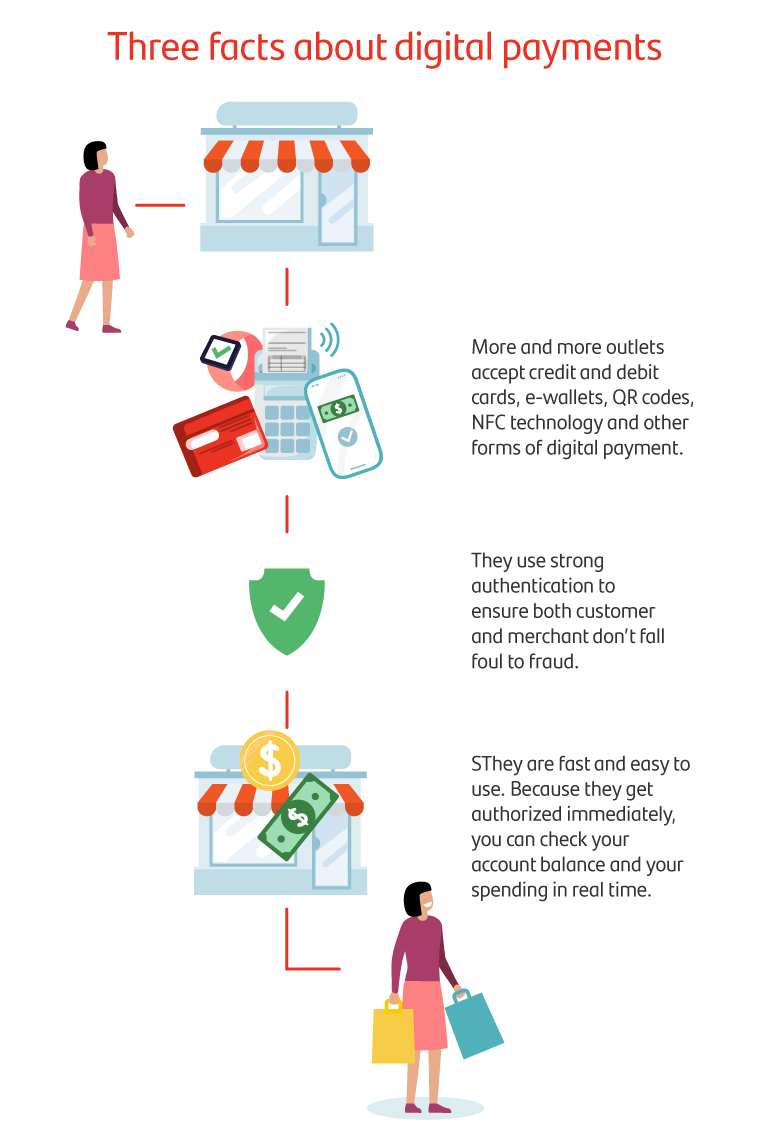Digital payments: How to settle up without cash or card when travelling abroad


Digital banking makes it easier to enjoy an enriching travel experience. If you’re planning to go abroad, you had better think about how to pay your way, wherever you go. Online banking and mobile apps are easy, efficient and secure options.
Sophia has been saving for months to take her first trip to another country. Having bought plane tickets, booked a hotel and taken out travel insurance, she’s now wondering how she can manage her money on her trip. First, she draws up a budget to work out how much money she’ll need.
A budget will prove useful to keep track of Sophia's finances and figure out the best payment method. She decides to keep cash to a minimum to reduce the risk of it getting lost or stolen. She prefers making cashless, digital payments online and with an app.

Choosing the right digital payment method
Digital payments transfer funds through credit and debit cards, e-wallets, or devices that have near-field communication (NFC) or QR code technology. With e-wallets, you can ditch your change purse, since they store all your payment information securely. They work on computers and smartphone apps. Before travelling abroad, check how "digitalized" the country is and common ways to pay without cash.
Digital banking is widespread where Sophia’s going. She can even use it on public transport and in small shops. She decides she’s going to pay with:
Do I need Internet to pay with my smartphone?
It depends on the settings of your digital banking app or virtual card or wallet. If your smartphone has NFC technology, it might not need to be connected to the Internet for payment to go through. It could also limit how much you can pay if it's offline. And if your payment app won't work without Internet, you should ask your mobile provider about its roaming rates. You might even want to look into mobile data plans to buy on your trip. Never connect to public Wi-Fi networks to make payments or enter personal details on other people’s devices. If your bank information gets stored, cyber criminals could use it to commit fraud.
Credit and debit cards
Bank cards have been around for ages and are a widely accepted payment method. They also work in many ways: you can swipe them, insert their “chip and pin”, or tap them on a POS terminal with “contactless” NFC technology. Some cards might not let you make payments abroad for security reasons. But many banks allow you to enable cards in other countries either on their app or by phone. What's more, bank apps can let you disable a lost card and set daily purchase and withdrawal limits. You should also check if your bank charges a currency conversion fee.
Mobile payments
More people are paying with a smartphone. Smartphones enable you to pay with a banking app, an e-wallet, a virtual credit or debit card and in other ways. Make sure your smartphone is NFC-enabled — most smartphones are — to transfer payment information to a POS system. Sophia added her bank card to her e-wallet for small expenses on her trip. That way, she’ll be able to keep an eye on her spending and stick to her budget.
Online purchases
Sophia wants to visit theme parks and museums on her trip; but she isn’t sure she can fit it all in. She’s made sure she can use her bank card to buy tickets on park and museum websites. She just needs to enable her card to make online purchases and be used abroad before she goes. She should also check if her banking app can send her push notifications to authorize payments.







